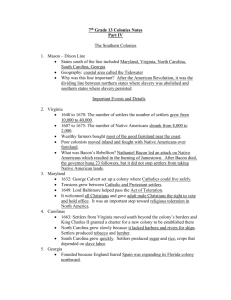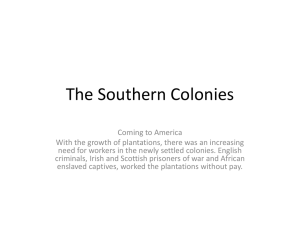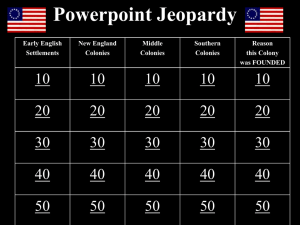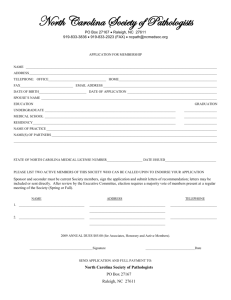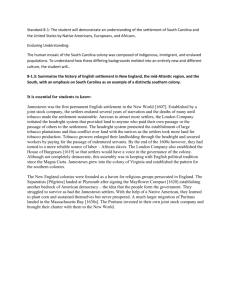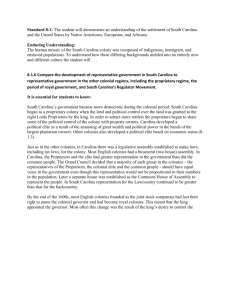NAME: 8-1 BOOK Standard 8-1: The student will demonstrate an
advertisement
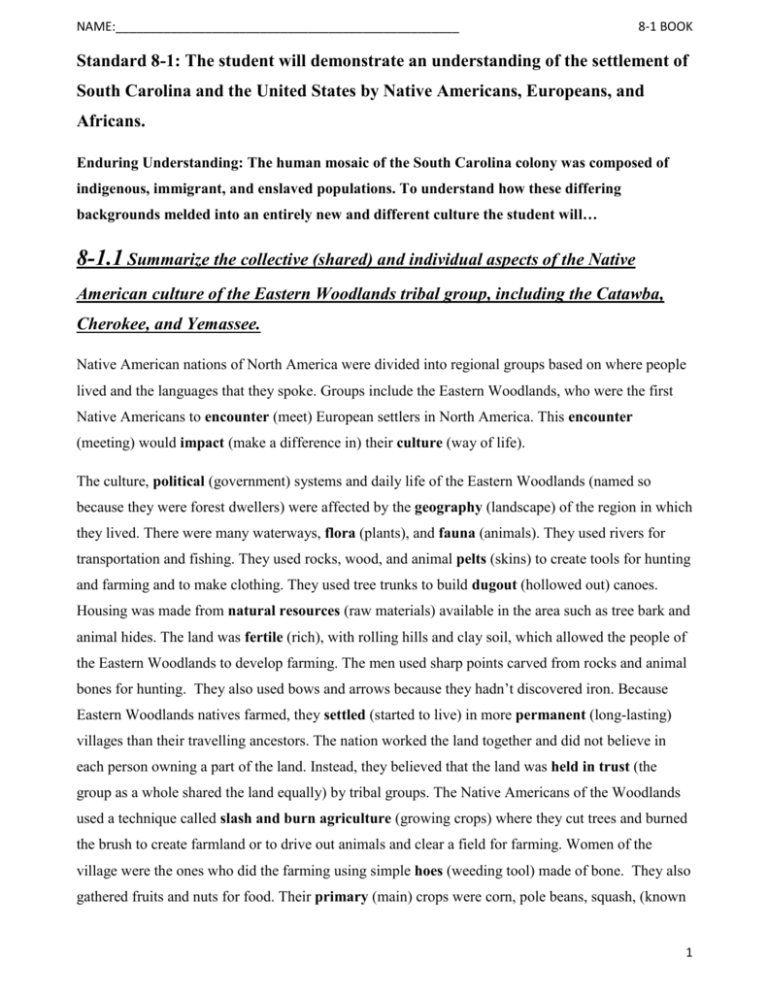
NAME:__________________________________________________ 8-1 BOOK Standard 8-1: The student will demonstrate an understanding of the settlement of South Carolina and the United States by Native Americans, Europeans, and Africans. Enduring Understanding: The human mosaic of the South Carolina colony was composed of indigenous, immigrant, and enslaved populations. To understand how these differing backgrounds melded into an entirely new and different culture the student will… 8-1.1 Summarize the collective (shared) and individual aspects of the Native American culture of the Eastern Woodlands tribal group, including the Catawba, Cherokee, and Yemassee. Native American nations of North America were divided into regional groups based on where people lived and the languages that they spoke. Groups include the Eastern Woodlands, who were the first Native Americans to encounter (meet) European settlers in North America. This encounter (meeting) would impact (make a difference in) their culture (way of life). The culture, political (government) systems and daily life of the Eastern Woodlands (named so because they were forest dwellers) were affected by the geography (landscape) of the region in which they lived. There were many waterways, flora (plants), and fauna (animals). They used rivers for transportation and fishing. They used rocks, wood, and animal pelts (skins) to create tools for hunting and farming and to make clothing. They used tree trunks to build dugout (hollowed out) canoes. Housing was made from natural resources (raw materials) available in the area such as tree bark and animal hides. The land was fertile (rich), with rolling hills and clay soil, which allowed the people of the Eastern Woodlands to develop farming. The men used sharp points carved from rocks and animal bones for hunting. They also used bows and arrows because they hadn’t discovered iron. Because Eastern Woodlands natives farmed, they settled (started to live) in more permanent (long-lasting) villages than their travelling ancestors. The nation worked the land together and did not believe in each person owning a part of the land. Instead, they believed that the land was held in trust (the group as a whole shared the land equally) by tribal groups. The Native Americans of the Woodlands used a technique called slash and burn agriculture (growing crops) where they cut trees and burned the brush to create farmland or to drive out animals and clear a field for farming. Women of the village were the ones who did the farming using simple hoes (weeding tool) made of bone. They also gathered fruits and nuts for food. Their primary (main) crops were corn, pole beans, squash, (known 1 NAME:__________________________________________________ 8-1 BOOK as the “three sisters”), pumpkins, and bottle gourds. These crops were planted together using corn stalks as poles for the beans. They also grew tobacco. There were many Eastern Woodlands tribes in South Carolina. Each had specific (particular) ways of living depending upon where they lived. South Carolina tribes shared the Algonquin language and preserved (kept record of) their history through the oral (verbal) tradition of storytelling. The three most important tribes were the Cherokee of the mountains, the Catawba of the Piedmont region, and the Yemassee who lived along the coast. The Cherokee nation lived in the foothills and mountains of South Carolina when they first met the Europeans. The Cherokee called themselves ‘the real people’ and were a powerful nation. The Cherokee lived in villages of up to six hundred people. The village was surrounded by a palisade (wall) for protection. Their summer homes were open to the air; their winter homes were round structures (buildings) with thick walls made of a mixture of grass and clay called daub. The roofs were made of bark and branches called wattle. The men fished by poisoning the water with walnut bark (outer layer of a tree). This stunned (shocked) the fish and made them rise in the water to be gathered. Leaders of the village, including women, met as a council (group leaders that make decisions for their whole group) to make rules for the nation. In times of peace, the village was led by a White leader (dressed in white); in times of war, the Red leader (dressed in red) took over. Each village also had a holy man or woman. The Catawba tribe, who called themselves the “river people”, lived along the rivers of the Piedmont region in villages surrounded by a palisade (wall). Their homes were wigwams (tepees) made of sapling (young tree) frames covered with bark or mats made of grasses and reeds. The Catawba leaders made the rules for the people and also had council houses in their villages. The Catawba were great potters, using clay that they shaped into pots. The Yemassee nation was originally from Spanish Florida (now called Georgia) but later moved to the coast of South Carolina near the mouth of the Savannah River. The Yemassee nation moved to escape the Spanish governor. During the summer the people lived on the beach in wigwams (tepees) covered with palmetto leaves which were plentiful (a lot of) in the area. During the fall, winter, and spring they lived farther inland (away from the coast) in wattle and daub homes like the Cherokee with a roof of palmetto leaves. Clams and oysters were part of their diet (what they ate). The Yemassee also had a council that sometimes included women. The Yemassee fled (ran away) to Florida after the Yemassee War with the settlers. 2 NAME:__________________________________________________ 8-1 BOOK When Europeans arrived, the people of the Eastern Woodlands traded furs and deerskins for iron tools, weapons, and guns. As the settlers became more prosperous (rich) and numerous (more of them), they took over more of the native peoples’ lands, cheated them in trade, and forced some of the natives into slavery. Settlers taking the natives’ lands, cheating them (in trade), and making them slaves led to hostilities (war) between the settlers and the people of the Eastern Woodlands nations. 8-1.1 OBJECTIVES: 1. Compare the characteristics of the Catawba, the Cherokee and the Yemassee. How were they different? How were they the same? 2. Exemplify (identify examples of) their methods of hunting and farming. What tools did they hunt with? How did they farm? Which crops were most important? 3. Explain their use of natural resources and geographic features. How did they use the land to provide food, clothes, and shelter? 8-1.2 Compare the motives, activities, and accomplishments of the exploration of South Carolina and North America by the Spanish, French, and English. As a result of the explorations of Columbus and later Spanish explorers, and the actions of the conquistadors (explorers seeking gold), the Spanish claimed large areas of Central and South America. Initially (at first) explorers searched for gold but soon set up encomiendas (large plantations) where they put natives to work to produce (make) more wealth (money/gold) for their Spanish masters. Disease and overwork soon decimated (destroyed) the native population. Because their Native American slaves died, the Spanish brought in African slaves to work the plantations and mines. They built cities and established universities. The Spanish transferred (move from one place to another) a complex social class system, their style of government, and their Catholic religion to the New World. Spanish explorers then extended (moved further) their search for gold and claimed land in North America. They established (set up) settlements (towns) in what is now Florida and South Carolina and the southwestern parts of the continent. By the time of the American Revolution, the Spanish established (set up) missions (fort/town built to spread religion) along the Pacific coast, enhancing their claim to the area. French explorers, searching for the Northwest Passage (a sea route from Canada for trade), sailed down the St. Lawrence River and claimed the region (said that they owned the land) for France. 3 NAME:__________________________________________________ 8-1 BOOK They established settlements at Montreal and Quebec (places in Canada). Although relatively few (not many) Frenchmen settled in these cold climates, they brought their culture (way of life) with them. French Protestants (non-Catholics) were not allowed to immigrate (move into) to the New World so the French colony was Catholic. French traders established (set up) good relations (dealings) with the native peoples. The French relied (depended on) on the native peoples for trade in furs (animal hair-high demand/expensive in Europe). Frenchmen traveled along the rivers, including the Mississippi River, and claimed those lands for France. The French named the land along the Mississippi River, Louisiana, after their king, Louis. Not to be outdone, English explorers also sailed along the coast of North America, claiming these lands for the English King. They would later establish permanent settlements (set up long-term towns) along the eastern coast naming them Virginia and New England. Some settlers were attracted to these regions hoping to discover gold. When those settlers did not find any gold, they stayed to grow tobacco. Others were fleeing (running) from religious persecution (discrimination) in England and founded societies based on their shared religious values (formed groups that believed in the same things). All English settlers brought their culture, including their language, Protestant religions, and ideas about self-government (democracy), with them to the New World. Spain, France, and England vied for a foothold (competed for a part) in South Carolina as part of the competition for colonies that would enrich (make stronger and richer) the mother country (their home country). Although a Spanish explorer, Hernan de Soto, traveled through what is now South Carolina looking for gold, neither Spain nor France were able to establish a permanent settlement in South Carolina. Problems in the Spanish and French mother countries led to lack of support (no help) for their settlements and bad living conditions at the settlements resulted in their abandonment (leaving). Spain founded the San Miguel de Gualdape settlement along the Waccamaw River near what is now Georgetown (city located on the coast north of Charleston) [1520s] but abandoned (left) it. The French then founded Charlesfort near what is now Beaufort (city located on the coast south of Charleston) but also abandoned it [1560s]. The Spanish again tried to establish a foothold (claim a part of) and founded San Felipe, which was built on the abandoned settlement of Charlesfort. San Felipe settlement survived for ten years until it was attacked by Native Americans. Survivors fled (ran away) to St. Augustine, Florida. Finally the English founded (set up) a settlement which became the first permanent colony (Charles Town) in South Carolina [1670]. 8-1.2 OBJECTIVES: 1. Explain the development of the settlements from the first attempts to settle at 4 NAME:__________________________________________________ 8-1 BOOK San Miguel de Gualdape, Charlesfort, and San Felipe. Where was each settlement located? Were these settlements successful? Why or why not? 2. Compare the motives of the Spanish, French, and English to settle in North America. Why did the Spanish want to explore/settle there? Why did the French want to explore/settle there? Why did the English want to explore/settle there? 8-1.3: Summarize the history of English settlement in New England, the midAtlantic region, and the South, with an emphasis on South Carolina as an example of a distinctly southern colony. Jamestown was the first permanent (long-lasting) English settlement in the New World [1607]. Established by a joint stock company (a business with many owners who pay to be a part), the settlers endured (suffered through) several years of starvation and the deaths of many until planting the tobacco crop made the settlement sustainable (able to keep up and running). Anxious (worried) to attract more settlers, the London Company (the stock company that ran Jamestown) initiated (started) the headright system that provided land to anyone who paid their own passage (boat ticket) or the passage of others to the settlement. The headright system promoted the establishment of (pushed people to build) large tobacco plantations. Conflicts started between settlers and the natives because the headright system gave away lots of land and settlers wanted a lot of land to grow tobacco. Tobacco growers enlarged their landholding (got more land) through the headright and secured (got) workers by paying for the passage (boat ticket) of indentured servants (people who agreed to work for a person for 3-7 years if their boat ticket from Europe to America was paid). By the end of the 1600s however, planters had turned to a more reliable source of labor – African slaves. The London Company also established (set up) the House of Burgesses (first assembly of elected representatives of English colonists in North America) in 1619 so that settlers would have a voice in the governing the colony. Even though it wasn’t completely democratic (run by the elected people), this assembly (like a congress) was like the English way of government since the Magna Carta. Jamestown grew into the colony of Virginia and established the pattern for the southern colonies. The New England colonies were founded as a haven (safe place) for religious groups persecuted (mistreated) in England. The Separatists [Pilgrims] (a group that wanted to separate from the Church of England and start their own local churches) sailed across the Atlantic Ocean and landed at Plymouth (a place in what is now Massachusetts). The Separatists then signed the Mayflower Compact in 1620 (first governing document of Plymouth Colony-like a constitution). This document 5 NAME:__________________________________________________ 8-1 BOOK established another bedrock (base) of American democracy - the idea that the people form the government. The Separatists [Pilgrims] struggled to survive just like the settlers in Jamestown. A Native American taught the Pilgrims how to plant corn. This corn stopped the Pilgrims from starving but their colony still didn’t grow. A much larger migration (movement) of Puritans landed in the Massachusetts Bay [1630s]. The Puritans invested (spent money to start) in their own joint stock company and brought their charter (deed to the land) with them to the New World. Consequently they established a democratic form of government (run by the elected people that live there) that included town meetings and a general assembly (a congress). All male church members could vote. They prospered (grew bigger and stronger) almost immediately by harvesting (cutting down) the lumber of the great northern woods, building ships, and trading with others. They established schools so that their children could learn to read the Bible and established religious conformity (everyone shared the same religious beliefs and traditions). Dissenters (people who wouldn’t believe or live like the Puritans did) were exiled (put out) to other parts of the region. Puritan families were large so the population grew and spread to other areas of New England. The families that spread out continued to have the same religious and governing ideas wherever they moved to. New Englanders enjoyed religious homogeneity (share the same religious beliefs), a thriving (successful) economy based on trade, and a democratic government (run by the elected people). Settlers to the Middle Colonies included a great variety (many different) of Europeans, including the Dutch (people from the Netherlands) who first settled New York and the Swedes (people from Sweden) who first settled Delaware. English Puritans also moved into the Middle Colonies and English Quakers settled Pennsylvania. The Quakers were a group of religious dissenters (rebels) who believed that everyone had an inner light. They promoted (supported) religious tolerance (acceptance) and good relations with the natives in their region and so the colony attracted many other groups of people. The Middle Colonies had the greatest diversity of people and religions in British North America. The king of England (Charles II) granted (gave) William Penn land in the New World (also known as Pennsylvania). This meant that Penn had the rights of a proprietor (landlord) and could name the governor of the colony. Pennsylvania also had a representative assembly as did the other colonies in the region. The Middle Colonies were founded to make a profit (money). This region’s economic prosperity was due to its good harbors and fertile fields. It became known as the ‘breadbasket’ of the colonies. South Carolina was founded as a proprietary (landlord) colony when the king of England (Charles II) granted (gave) land to the eight Lords Proprietors (head landlords or overseers of a territory) in 6 NAME:__________________________________________________ 8-1 BOOK payment of a debt. The proprietors hoped to make a profit by charging settlers a quitrent (rent money) on the settlers land. The proprietors commissioned (hired) John Locke to write the Fundamental Constitutions of Carolina. This document wrote out policies (rules), such as religious toleration, designed to attract settlers. It also included provisions (requirements) for setting up a social class system where people who owned a lot of land were given special titles (names) that meant they were higher up in society than other people. Although this provision was never upheld, it shows the intention (goal) to make Carolina a society based on deference (respect) to the elites (cream of the crop), unlike the experiences in New England and the middle colonies where religion at first emphasized equality (promoted fairness). In order to encourage immigration (get people to move), the proprietors granted (gave away) large tracts (areas) of land to settlers through the headright system, just like they did in Virginia. The headright system led to the establishment of large plantations based on cash crops (crops grown to sell for a profit) that made South Carolina a distinct (different) southern colony. The first settlers to South Carolina were Englishmen who emigrated (moved away) from the British colony of Barbados (an island in the Caribbean Sea) and brought a well-developed slave system with them (8-1.4). Slavery made the plantation owners very wealthy (8-1.5). Other settlers that were attracted to the prosperous (money making) colony came from France, Switzerland, Germany, Scotland, and Ireland. Assured of religious choice (guaranteed the right to believe what they wanted) by the Fundamental Constitutions, settlers came from diverse religious backgrounds, including French Huguenots (Protestants from France) and Jewish settlers. The South Carolina colony’s natural resources, including fertile land, a mild climate, and many waterways, also contributed to the development of plantations and prosperity (8-1.5). Originally the Lords Proprietors controlled the government through a Governor and Grand Council, which included representatives of the proprietors, the Carolina elite and a smaller representation of the common people of the colony. Just as in the other colonies, Carolina had some degree of democracy (a small amount of their own control) from the beginning (8-1.6). 8-1.3 OBJECTIVES: 1. Summarize the history of European settlements in the New World. Where was the first successful English settlement in North America? Why was this settlement successful? How was this settlement governed? What types of people settled in New England and why? 2. Summarize the history of European settlements in the mid-Atlantic region. What types of people settled the Middle Colonies? Why were the Middle Colonies founded and what made them successful? 7 NAME:__________________________________________________ 8-1 BOOK 3. Summarize the history of European settlements in the South. Why was settlement in South Carolina successful? How was this settlement governed? What types of people settled in the South and why? What were their social classes based on? 8-1.4: Explain the significance (importance) of enslaved and free Africans in the developing culture (way of life) and economy(money) of the South and South Carolina, including the growth of the slave trade and resulting population imbalance between African and European settlers; African contributions to agricultural development; and resistance to slavery, including the Stono Rebellion and subsequent laws to control slaves. African Americans played a significant (important) role in the developing (growing) economy of South Carolina. The economy of South Carolina, like the economies of other southern colonies, was largely based on the plantation system. Most of the crops were labor intensive (really hard work), requiring many workers to cultivate (prepare/plant) the land. In Virginia, indentured servants (people who agreed to work for a land owner in exchange for the cost of a boat ticket from Europe) were used as laborers at first. However, by the time Carolina was settled, there were fewer workers willing to accept a contract of indenture. Initially (first off), Carolina planters attempted (tried) to use Indians as workers, however natives could easily escape into the land that they knew and male natives were not accustomed to cultivating (used to working on/preparing) the land. Carolina settlers from Barbados brought their slaves with them. Additional (more) slaves were forced through the “Middle Passage” from the west coast of Africa by way of the West Indies and sold on the auction block. These Africans brought with them the knowledge of cultivation (knowing how to prepare land for crops) from their native lands (Africa), including the knowledge of tending cattle (raising cows) and cultivating rice (growing rice). Africans were also used to harvesting the naval stores (getting tar from trees to make boats watertight) and lumber (wood) from the forests of the Carolinas that contributed (helped make) to a thriving (successful) trade with Barbados and Britain. With the development of cash crops and the plantation system came an increase (rise) in the slave trade. Large-scale importation (bringing in) of African slaves began in the 1690s and thousands of African slaves came to South Carolina and the South through the port (harbor) of Charleston. The growing demand for both rice and indigo led plantation owners to import (bring in) more slaves. 8 NAME:__________________________________________________ 8-1 BOOK Slaves brought their African culture (way of life/beliefs) directly from West Africa, including language, dance, music, woodcarving, folk medicine and basket weaving. African rhythms could be heard in the call and response songs that slaves used to sustain (keep up) their work and their spirit. Drums kept the beat of the fields and communicated with slaves on other plantations until they were banned (not allowed) by fearful whites after the Stono Rebellion. Foods such as yams (sweet potatoes) became a staple (essential part) of the southern diet. Gullah was both a spoken language and the shared culture of Africans that developed in the Sea Islands off the coasts of South Carolina and Georgia, where it is called Geechee. A mixture of many spoken languages combined with newly created words, the Gullah language was unique to the coastal region because of this area’s limited access (not many ways to get to) and the large concentration (a lot in one place) of Africans. As early as 1698, the Assembly (governing body) began to worry that there were too many slaves in the colony but, because slaves were vital (critical/essential) to the economic success of the colony, the Assembly did not want to limit the number of slaves coming into the colony. With the demand (need/want) for more slaves came an increase in the slave trade that created a population imbalance (more of one group than another). Slaves outnumbered whites by large numbers in many areas and this population imbalance raised concerns (fears) about controlling the slave population. The Stono Rebellion, a slave revolt (riot) near Charles Town, significantly increased this concern. This uprising began when a small group of slaves, who wanted to escape to St. Augustine, Florida where the Spanish said they would be free, broke into a store on the Stono River and killed two settlers. Using their drums, the rebels summoned more slaves to join them. By day’s end, many settlers and slaves had been killed. As a result of the Stono Rebellion, slave codes (laws restricting slaves) that were originally brought from Barbados, were strengthened. Slaves codes [the Negro Act of 1740] prohibited slaves from gathering without white supervision, learning to read and write, and carrying guns. Much of the Negro Act was devoted to controlling minute aspects (small parts) of a slave’s life. For example, slaves were not allowed to dress in a way "above the condition of slaves." It created harsher punishments for disobeying the law and also fined slave owners who were cruel to their slaves. What was most important to the colonists was that the codes established tighter control of their slaves. Even after the Stono Rebellion, the slave trade was not limited (restricted). South Carolina had fewer (less) free Africans-American than many other colonies. The state legislature (governing body) acknowledged (accepted) the right of owners to free, or manumit, their slaves for good cause in the early 1700s. Some slaves were free by the last will and testament of their owners, for faithful service, or from masters freeing their slave mistresses and their children. However this occurred rarely (not often) because the slaves were so valuable. Some slaves were able 9 NAME:__________________________________________________ 8-1 BOOK to purchase their freedom as the result of having some special talent or skill that allowed them to be hired out and earn money which they used to purchase their freedom. However, free blacks were required by law to leave South Carolina within 6 months or be re-enslaved and sold at auction. Very few free blacks [4%] lived in the South. Free blacks were most likely to live in urban (city) areas where they were able to earn a living by their craft. After the American Revolution, restrictions (limits) on the rights of owners to free their slaves were further legislated (made into law). 8-1.4 OBJECTIVES: 1. Explain the growth of the African American population during the colonial period. Why did the amount of slaves increase so much during the colonial period? How did the slave population compare to the non-slave population? 2. Explain the significance of African Americans in the developing culture and economy of South Carolina. How did African culture change the south and South Carolina? In what ways did African slaves impact the economy of South Carolina? 3. Explain the significance of African contributions to agricultural development What skills did Africans have before coming to South Carolina? How did those skills help slave owners? 4. Explain the significance of enslaved Africans resistance to slavery. In what ways did Africans resist slavery? How did whites react to this resistance? How did this resistance affect the slave trade? 8-1.5: Explain how South Carolinians used their natural, human, and political resources uniquely to gain economic prosperity, including settlement by and trade with the people of Barbados, rice and indigo planting, and the practice of mercantilism. South Carolina’s natural resources included abundant (many) deer that could be hunted for its skins and pine forests to harvest. Carolina also had broad expanses (wide areas) of fertile land, a mild (not too hot not too cold) climate, and a long growing season. Geographic conditions in the Lowcountry made it suitable (just right) for rice planting. A good port at Charleston and navigable (passable) waterways along the coast and into the interior made shipping goods to market possible. 10 NAME:__________________________________________________ 8-1 BOOK A flourishing (booming) trade made the Carolinas a profitable colony all because of how they used the natural resources available in South Carolina. Initially, traders obtained (got) furs and deerskins from Native Americans in exchange for beads, trinkets, guns and alcohol. The good relationship between traders and Native Americans ended when some Native Americans were forced into slavery. Because the early Carolina settlers came from Barbados, South Carolinians established (set up) a thriving trade with this Caribbean island. Carolinians sold cattle (cows) and Native American slaves to the people of Barbados. South Carolina pine trees were a source of (place to get) pitch and tar (naval stores) which the British used for making ships watertight. The growing African slave trade brought not only laborers (workers) but also their knowledge of cattle herding and rice planting to the Carolinas (8-1.4). Rice became known as “Carolina Gold,” a staple (must have) crop and the source of long- term prosperity (how they made money for a long time). The determination of the settlers and the hard work of their slaves resulted in (led to) a growing agricultural economy (making money from farming). As an immigrant from Antigua (island in the Caribbean), Eliza Lucas planted indigo because she was determined to make the family plantation successful. Indigo was a plant used to make a highly valued blue dye and the British government was offering a subsidy (money) as an incentive (motivation) to anyone who would grow it. Eventually, Eliza Lucas succeeded and shared her success with other area planters. Indigo became a new cash crop for South Carolina. Political factors (government issues) also contributed (added) to South Carolina’s prosperity (richness). Mercantilism was an economic (financial) system where the mother country controlled trade in order to export (send out) more goods than it imported (bring in). By enforcing mercantilist policies (rules), the mother country would amass (collect) more gold and silver and become wealthy and powerful. South Carolina served as both a source of raw materials (a place to get material from the land) and a market (store) for British manufactured goods. This lessened the mother country’s dependence (need for) on foreign trade and thus improved her balance of trade (exports over imports). The British government encouraged the development (growth) of new products such as indigo by offering subsidies (or money) to planters who grew it. Both rice and indigo were on the ‘enumerated’ list (written list of goods) of products that could be sold only to England. Carolina planters therefore had a secure market (protected place) in which to sell their crops. However the British government did not enforce (make them do) this part of the law on Carolina rice, which gave South Carolina the economic advantage (could make more money than others) because they had a wider market (more countries/people to sell to). Indeed the British government was lax (slack) in its enforcement of most mercantilist laws (a condition known as salutary neglect) and so the people of 11 NAME:__________________________________________________ 8-1 BOOK British North America were free to develop their economies (improve/change the way they made money) without much interference from the mother country. 8-1.5 OBJECTIVES: 1. Explain how South Carolinians used natural resources, human resources, and political resources to gain economic prosperity. How did colonists use the land to make money? What were South Carolina’s human resources and how were they used to make money? How did South Carolina use the trade policy to make money? 2. Explain how each of the following made South Carolina a prosperous colony: How did trade with Barbados make South Carolina a prosperous colony? How did rice planting make South Carolina a prosperous colony? How did Eliza Lucas Pinckney and indigo planting make South Carolina a prosperous colony? How did the slave trade make South Carolina a prosperous colony? How did the practice of mercantilism make South Carolina a prosperous colony? 8-1.6 Compare the development of representative government in South Carolina to representative government in the other colonial regions, including the proprietary regime, the period of royal government, and South Carolina’s Regulator Movement. South Carolina’s government became more democratic (run by the elected people) during the colonial period (time period where S.C. was controlled by the mother country). South Carolina began as a proprietary colony (run by landlords) when the land and political control over the land was granted (given) to the eight Lords Proprietors by the king. In order to attract (bring in) more settlers the proprietors began to share some of the political (government) control of the colony with property owners. Carolina developed political elite (rich people running the government) as a result of the amassing (building up) of great wealth and political power in the hands of the largest plantation owners. Other colonies also developed a political elite based on economic status (how much money a person has compared to others) (8-1.3). Just as in the other colonies, in Carolina there was a legislative assembly (a group of people that set laws) established to make laws, including tax laws, for the colony. Most English colonies had a bicameral (two house) assembly. In Carolina, the Proprietors (landlords) and the elite (rich people) had greater representation (more of a say) in the government than did the common people. The Grand Council (representatives of the proprietors, the Carolina elite and a smaller representation of the common people of the colony) decided that a majority (more than half) of each group in the colonies – the representatives of the Proprietors, the colonial elite and the common people - should 12 NAME:__________________________________________________ 8-1 BOOK have equal voice (the same amount of say) in the government even though this representation would not be proportional (even) to their numbers in the population. Later a separate house (branch of government) was established as the Commons House of Assembly to represent (stand up for) the people. In the South Carolina Lowcountry, representation in the legislative assembly continued to be greater than that for the backcountry. By the end of the 1600s, most English colonies founded (started) as the joint stock companies (a business run by many people who wanted to make money) had lost their right to name (privilege to choose who) the colonial governor and had become royal colonies (a colony controlled by the King of England). This meant that the king appointed (chose) the governor. Most times, this change was the result of the king’s desire (want) to control the wealth (money made) or to limit the independence (freedom) of the colony. South Carolina became a royal colony at the invitation (request) of the colonists. Tension (conflict) between the colonists and the Proprietors grew because the colonists felt neglected (ignored) by the absentee (not living/being around) landlord who collected rent but offered (gave) them little protection from the Native Americans, Spanish, and pirates. The Proprietors thought that the colonists were disobedient and they were making little profit. The colonial Council protested (complained) to the king about the neglect of the proprietors and appealed (begged) to the king to make Carolina a royal colony. The king reached a financial agreement (money deal) with the Proprietors and Carolina became a royal colony and later was split into North and South Carolina. South Carolina continued to have self-government through their representative assembly but now had a governor who was appointed (chosen) by the king rather than (instead of) by the proprietors. The power of the royal governor was limited because colonial assemblies (group of elected representatives/colonists) controlled the taxes that paid the governor’s salary (paycheck). Most often the king and Parliament (government in England) left the colonies alone to control their own local government. South Carolina enjoyed some economic advantages (rewards) as a result of becoming a royal colony. The English government increased subsidies (aid) for naval stores (substance that made ships watertight) and allowed merchants (people who sell goods) to sell rice directly to foreign countries (8-1.5). The English government through (with the help of) the royal governor established (set up) townships (towns) in the backcountry to encourage migration (moving from one place to another). Settlers moved there to establish subsistence farms (farm where crops are grown just to feed the farmer and his family). This intensified (made stronger) the animosity (dislike) between the Lowcountry and the backcountry. The first white settlers to move to the backcountry were traders and woodsmen, so they were viewed (looked at) by the Lowcountry elite as “uncivilized.” (backwards/no 13 NAME:__________________________________________________ 8-1 BOOK education/no class) As the first area that was settled in the state, the Lowcountry along the Atlantic coast surrounding the city of Charleston, was the home of plantation owners who grew rich from the export of rice and indigo. As more coastal settlers moved inland and immigrants such as the Scotch Irish and the Germans traveled along the backcountry valleys from Pennsylvania, the backcountry’s white population grew to outnumber that of the Lowcountry. However the backcountry continued to have much less representation in the Assembly. Although they paid taxes, the backcountry folk got little in return from their colonial government. There was no law enforcement so settlers in the backcountry took the regulation of society into their own hands in what was called the Regulator movement. Because there were no courts, the Regulators operated as vigilantes (men who decided on one’s guilt or innocence). This movement to provide law and order through “self- regulation” turned lawless. The “guilty” were hanged or beaten to death without a jury trial, violating their rights as Englishmen. Eventually the government of South Carolina came to the aid of the backcountry settlers by setting up seven circuit courthouses (Circuit Court Act) around the colony to provide justice and law and order in the region. However, representation in the General Assembly was still disproportional (more representatives from the Lowcountry than the backcountry) and the tensions between the Lowcountry and the backcountry continued. 8-1.6 OBJECTIVES: 1. Summarize the significant changes to South Carolina's government during the colonial period. It what ways did South Carolina develop a representative government? In what ways did other colonial regions develop representative government? What was it like to live in South Carolina when it was controlled by the Lord’s Proprietors? Why did South Carolinians want to switch from having a proprietary government to a royal government? How did inaction by the government lead to the Regulator Movement? 2. Compare the proprietary regime and the period of royal government. 3. Explain the significance of the Regulator movement in colonial South Carolina. 14
